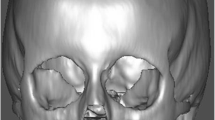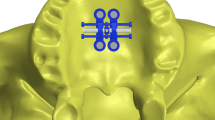Abstract
Background and Aim:
Rapid maxillary expansion not only has local effects on the midpalatal suture and the maxillary region, but also on deep anatomical structures of the viscero- and neurocranium. This study’s aim was to analyze the distribution pattern of stresses on the juvenile and adult sphenoid by the finite element method (FEM) induced by rapid maxillary expansion. Of special interest were stresses and deformations around the sphenoidal foramina with their vulnerable neural and vascular structures.
Material and Method:
A finite element model of the sphenoid consisting of 19,383 single elements was used for the analysis.
Results:
The virtual experiments showed that rapid maxillary expansion leads to moderate stresses and deformations in the juvenile sphenoid, so serious complications are unlikely in this region. The situation is different in adulthood because of decreasing elasticity of the skeletal structures. Due to lateral bending of the pterygoid processes, marked stress develops in the round and oval foramen regions and those of the superior orbital fissure, where fractures causing neural and vascular injury can occur.
Conclusion:
The surgical separation of the maxilla from the sphenoid is an important means of preventing complications in the region of the cranial base in adults.
Zusammenfassung
Hintergrund und Ziel:
Neben lokalen Effekten auf Maxilla und Sutura palatina mediana hat die forcierte Gaumennahterweiterung auch Auswirkungen auf tief liegende anatomische Strukturen des Viszero- und Neurokraniums. Ziel dieser Studie war es, die bei einer forcierten Gaumennahterweiterung induzierten Spannungen am juvenilen und adulten Keilbein mit Hilfe der Finite-Elemente-Methode (FEM) zu analysieren. Von besonderem Interesse waren dabei Spannungen und Deformationen, die in der Nähe der sphenoidalen Foramina mit ihren vulnerablen Nervenstrukturen auftraten.
Material und Methode:
Zur Analyse wurde ein Finite-Elemente-Modell des Keilbeins, das aus 19 383 Einzelelementen bestand, eingesetzt.
Ergebnisse:
Die virtuellen Experimente zeigten, dass die forcierte Gaumennahterweiterung beim juvenilen Keilbein zu moderaten Spannungen und Deformationen führt, so dass ernste Komplikationen unwahrscheinlich sind. Aufgrund der abnehmenden Elastizität knöcherner Strukturen ist die Situation bei Erwachsenen anders. Aufgrund der Aufbiegung beider Pterygoidfortsätze nach lateral traten im Bereich des Foramen rotundum, des Foramen ovale und der Fissura orbitalis superior beachtliche Spannungen auf, die zu Mikrofrakturen mit Verletzung nervaler und vaskulärer Strukturen führen könnten.
Schlussfolgerung:
Eine chirurgische Trennung der Maxilla vom Keilbein ist eine wichtige Maßnahme, um bei Erwachsenen Komplikationen an der Schädelbasis vorzubeugen.
Similar content being viewed by others
Author information
Authors and Affiliations
Corresponding author
Additional information
* This paper received the Arnold Biber Research Award of the German Orthodontic Society for the year 2004.
Rights and permissions
About this article
Cite this article
Holberg, C. Effects of Rapid Maxillary Expansion on the Cranial Base—an FEM-Analysis*. J Orofac Orthop 66, 54–66 (2005). https://doi.org/10.1007/s00056-005-0439-y
Received:
Accepted:
Issue Date:
DOI: https://doi.org/10.1007/s00056-005-0439-y




